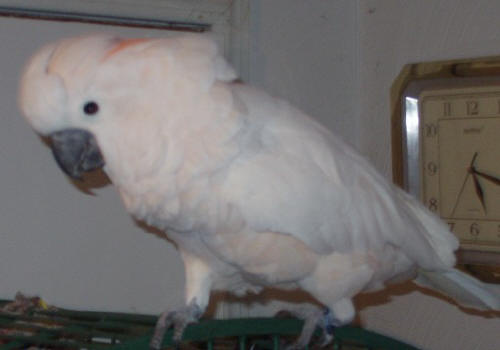Cockatoo - Moluccan
Salmon Crested Cockatoo Scientific Name: Cacatua moluccensis
Mon, 14th July, 2025 - 8:38 pm GMT
Sponsor Ads:

Alternative Name
Salmon Crested Cockatoo Scientific Name: Cacatua moluccensisBasic Info
Moluccan Cockatoos are larger parrots, measuring around 50 centimeters. Whitish salmon coloring is the predominate feather color on the Moluccan's body, but their deep salmon pink crest and under-feathers give a brilliant look. Orange, yellow, and pink can be found on the base of the tail-feathers, with a black bill topping off this beautiful specimen.
Health
Moluccan Cockatoos are, unfortunately are very prone to plucking and mutilation. No one knows why, other than these birds do not always adapt well to life in captivity. The cages that house most Moluccans, although large by our standards, are often not nearly large enough for a lifetime of living. As these birds can live to be 90 years old, the best environment appears to be a large aviary, of which most people cannot provide. Large cockatoos, like the Moluccan and Umbrella usually do wonderfully as pets for the first 2 years or so. Then, especially in the males, everything can change to the point that you will not recognize that "sweet baby" you brought home. Many people must get rid of their beloved companions at this point. This is why the rescues are overflowing with large cockatoos, especially the Moluccans. Please be careful when choosing your next parrot, and think twice about the large cockatoos unless you are familiar with the large amount of time and responsibility associated with these birds. They require large amounts of time and plenty of stimulation to prevent boredom. In addition, other factors which may cause them to do poorly are bad diets and stress.Habitat
N/ABehavior
The striking Moluccan Cockatoo has become one of the most popular Cockatoos in captivity, and is also one of the most common parrots seen in parrot rescues today. As with most wild animals that can be domesticated, Moluccan Cockatoos raised by hand and those born in the wild can hardly be given the same characteristics. Try cuddling up to a wild bird and you will understand what this means. In Indonesia, these birds can be seen by themselves or in small groups usually early and late in the day. They seem to prefer roosting in the taller trees of the forest usually close to their pair mate. Their loud cries are the only thing that gives them away at times, as they are shy and very cautious. Hand raised birds are quite the opposite; they trade in their wild aloofness for an overwhelming passion to be near people, and are more than gracious giving back the love their owners give to them. Unlike some birds kept in the home, Cockatoos seem willing to show their regard for all in the family. One of the requirements of a home Cockatoo is plenty of attention. While these birds are content with being by themselves, or another bird for a while they desire interaction with their human counterparts. The loud cries that wild birds exhibit are not lost on our domesticated allies, although many of them turn this noise into vocalizations. If a Moluccan Cockatoo is not given the amount of attention it desires they can and often will scream very loudly. Moluccan Cockatoos can be very noisy; it is reported that their voices can be heard as far as three blocks away. For this reason they may not be suitable for apartment living. Because of the intense time requirements these birds may not be well suited for people with a busy lifestyle, they require a lot of attention and love. Many people do not realize the time demands these birds place on their owners, and many suffer due to lack of proper care. It should also be noted that like many parrots, the Moluccan can often become more aggressive as they reach sexual maturity. Your once sweet and cuddly baby may all of a sudden change into a rather cranky individual. When a Moluccan is in a bad mood, one of the worst things an owner can do is to raise their voices to the parrot. This usually only gets them more excited and can increase their unwanted behavior. The Moluccan Cockatoo is one of the most common large parrots seen in rescue. Moluccan Cockatoos are highly intelligent creatures, though they are not known for their talking ability. Because of the intellectual nature of this bird, care must be taken to keep them occupied, even when we are not directly stimulating them. An assortment of perches and toys will keep your avian Einstein content and happy. Overall the Moluccan Cockatoo is one of the most loving parrots, be he also requires a lot of love in return. If you have the time and patience, a Moluccan Cockatoo may make a wonderful addition to your home.Origin
IndonesiaHistory
It is this animal's endearing qualities, along with habitat loss that have put the Moluccan Cockatoo on the endangered species list. Capture of the animals for trade has lead to the extinction of this breed from many of the Indonesian islands that it use to be found. In 1925 a specimen later to be named King Tut was given as a gift to the San Diego Zoo. Zookeepers soon fell in love with their new acquisition, and began to tame him. Although he was never as friendly as our modern hand raised birds he became quite responsive to people and soon became an unofficial greeter to the zoo, offering up salutations to entering zoo goers. King Tut served as an ambassador for his counterparts and introduced many people to this beautiful and interesting creature.Common Foods
N/ASponsor Ads:
"The onrush of a conquering force is like the bursting of pent-up waters into a chasm a thousand fathoms deep." -- Sun Tzu, The Art of War
Cockatoo - Moluccan
Coded by: BGID® | ALL RIGHTS RESERVED Copyright © 2000-2025
Disclaimer | Privacy | Report Errors / Contact | Credits
















